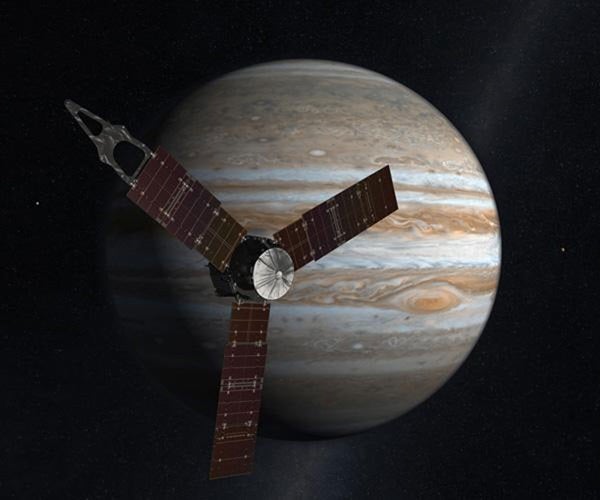Juno will arrive at Jupiter in July 2016 and orbit its poles 33 times to learn more about the gas giant’s interior, atmosphere, and aurora. “We’re about to start our journey to Jupiter to unlock the secrets of the early solar system,” said Scott Bolton, the mission’s principal investigator from the Southwest Research Institute in San Antonio, Texas. “After 8 years of development, the spacecraft is ready for its important mission.”
Now that the Juno payload is atop the most powerful Atlas rocket ever made — the United Launch Alliance Atlas V 551 — a final flurry of checks and tests can begin and confirm that all is go for launch. The final series of checks begins August 3 with an on-pad functional test. The test is designed to confirm that the spacecraft is healthy after the fueling, encapsulation, and transport operations.
“The on-pad functional test is the first of seven tests and reviews that Juno and its flight team will undergo during the spacecraft’s last 10 days on Earth,” said Jan Chodas, Juno’s project manager at NASA’s Jet Propulsion Laboratory in Pasadena, California. “There are a number of remaining prelaunch activities that we still need to focus on, but the team is really excited that the final days of preparation, which we’ve been anticipating for years, are finally here. We are ready to go.”
The launch period for Juno opens August 5 and extends through August 26. For an August 5 liftoff, the launch window opens at 11:34 a.m. EDT and remains open through 12:43 p.m. EDT.
Juno will arrive at Jupiter in July 2016 and orbit its poles 33 times to learn more about the gas giant’s interior, atmosphere, and aurora. “We’re about to start our journey to Jupiter to unlock the secrets of the early solar system,” said Scott Bolton, the mission’s principal investigator from the Southwest Research Institute in San Antonio, Texas. “After 8 years of development, the spacecraft is ready for its important mission.”
Now that the Juno payload is atop the most powerful Atlas rocket ever made — the United Launch Alliance Atlas V 551 — a final flurry of checks and tests can begin and confirm that all is go for launch. The final series of checks begins August 3 with an on-pad functional test. The test is designed to confirm that the spacecraft is healthy after the fueling, encapsulation, and transport operations.
“The on-pad functional test is the first of seven tests and reviews that Juno and its flight team will undergo during the spacecraft’s last 10 days on Earth,” said Jan Chodas, Juno’s project manager at NASA’s Jet Propulsion Laboratory in Pasadena, California. “There are a number of remaining prelaunch activities that we still need to focus on, but the team is really excited that the final days of preparation, which we’ve been anticipating for years, are finally here. We are ready to go.”
The launch period for Juno opens August 5 and extends through August 26. For an August 5 liftoff, the launch window opens at 11:34 a.m. EDT and remains open through 12:43 p.m. EDT.










